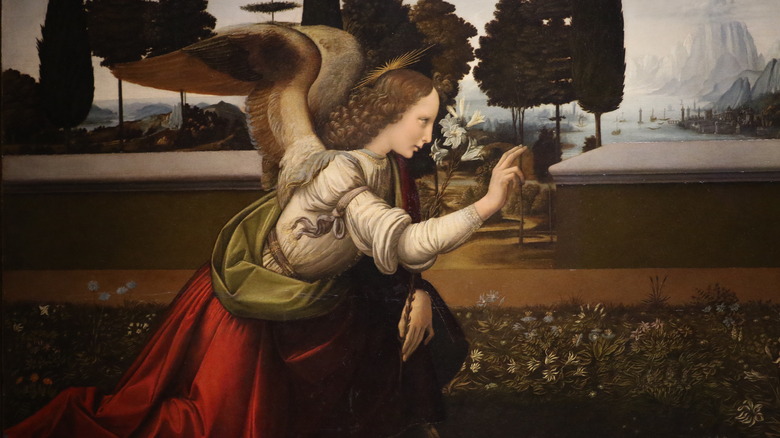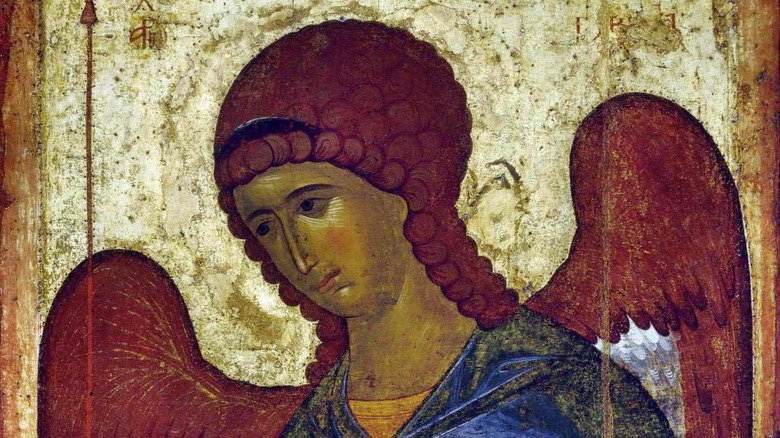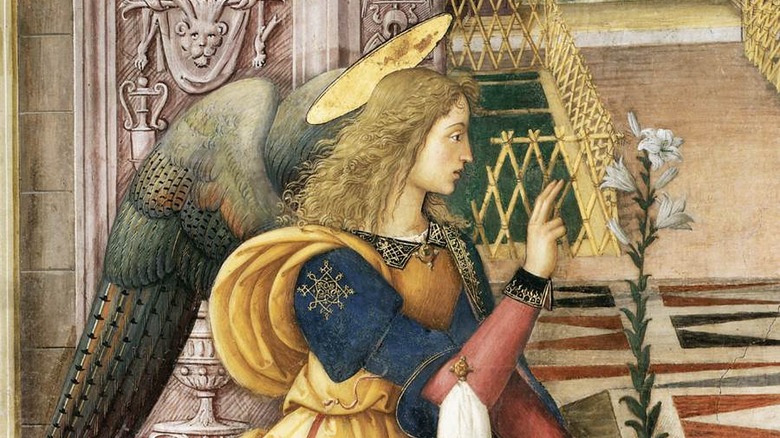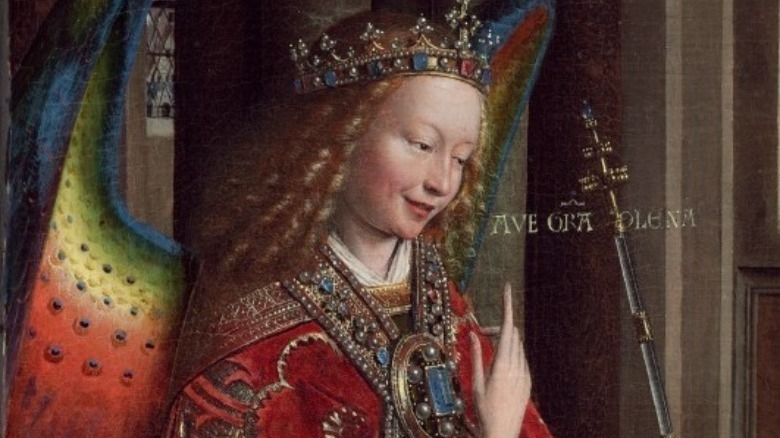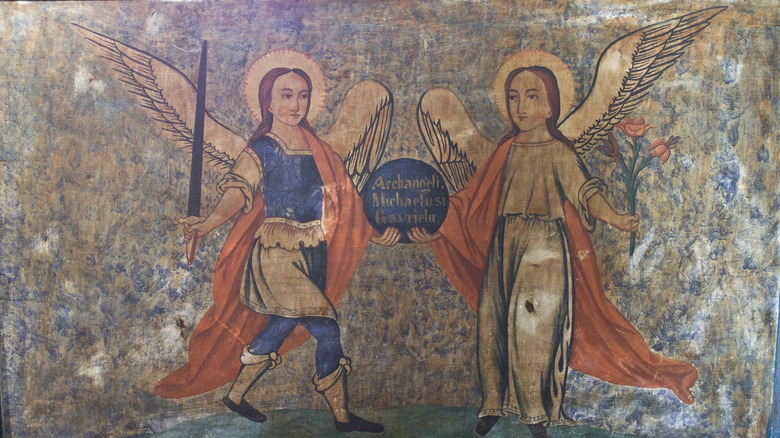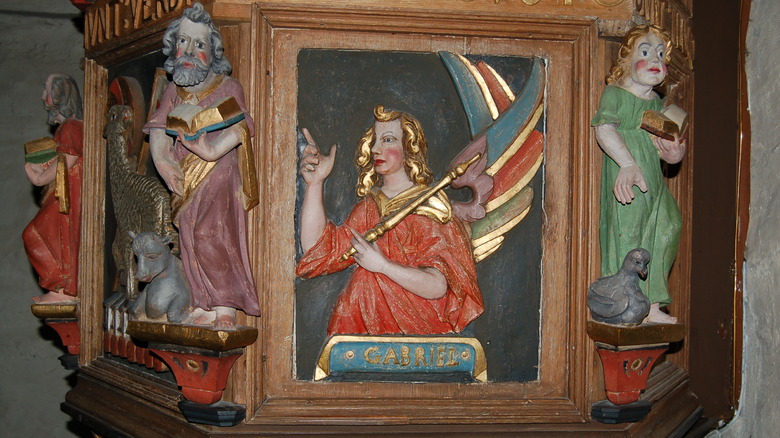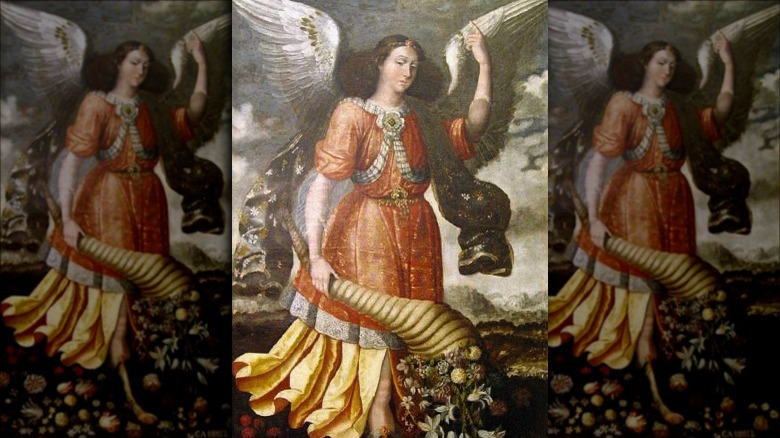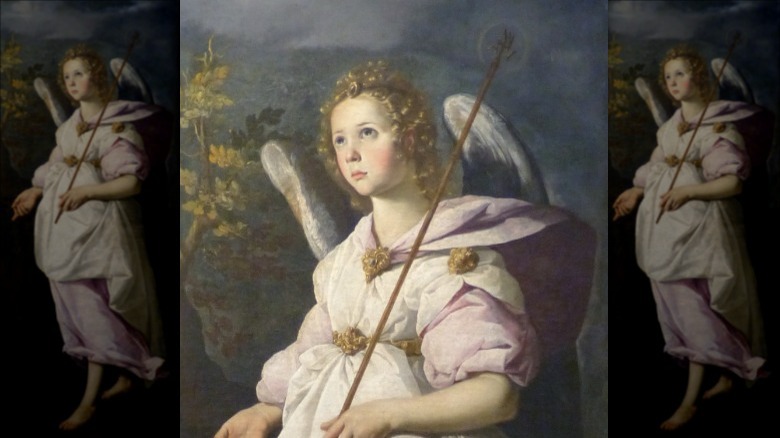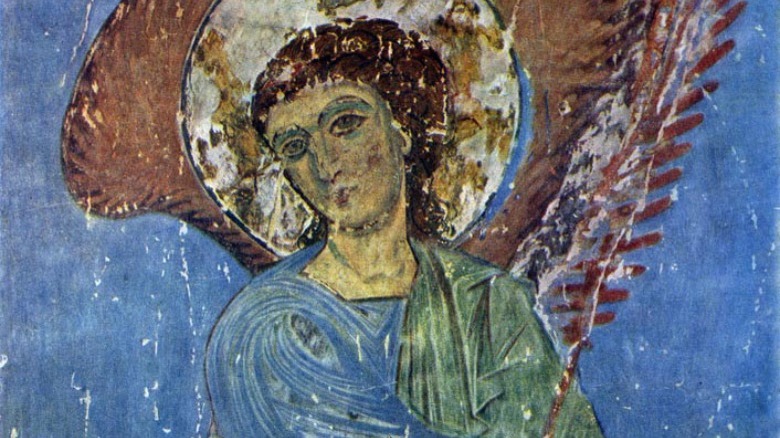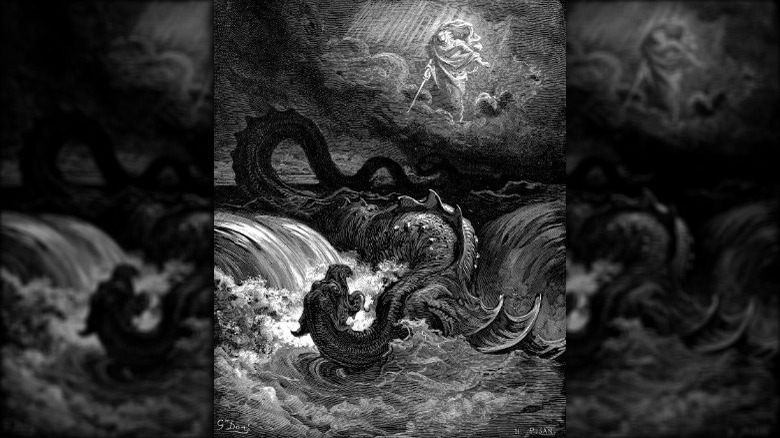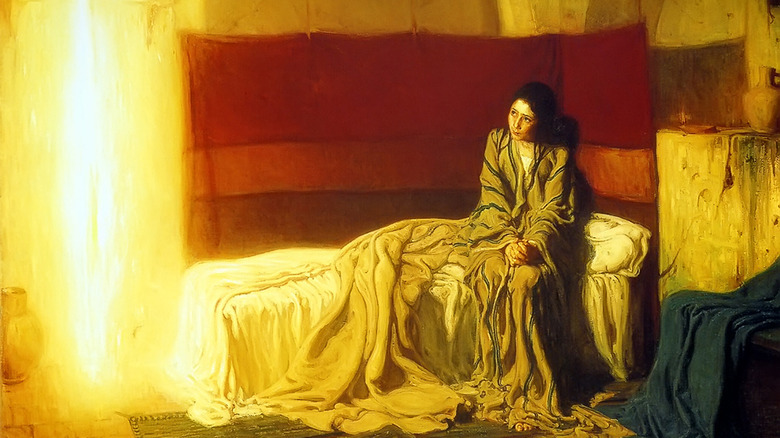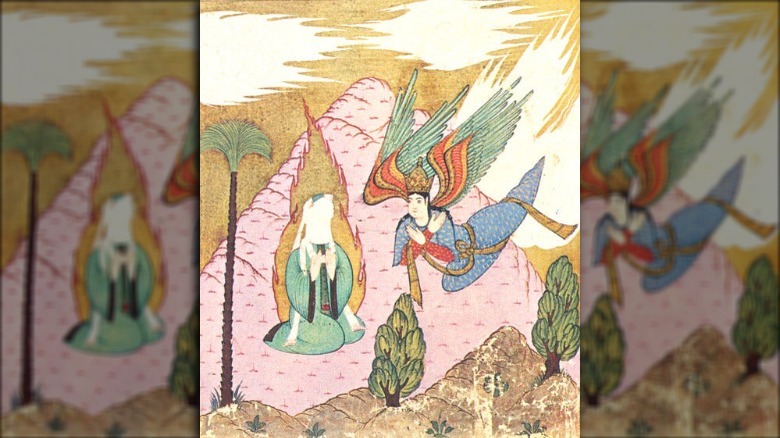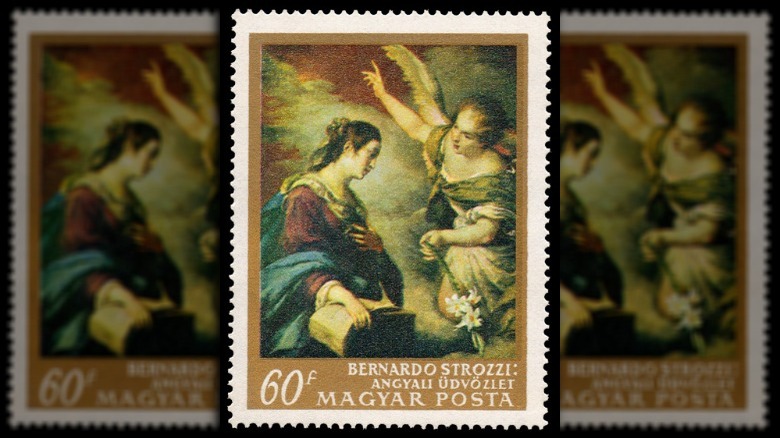The Archangel Gabriel: The Untold Truth
Thanks to him being the angel who tells the Virgin Mary that she's destined to give birth to the Son of God, it's possible that the best known of all the angels is the archangel Gabriel. However, officially, he's still second in importance behind the archangel Michael, the commander of God's armies who will throw Satan in the lake of fire and so on. But being the second-most important angel isn't too bad, all things considered.
Given how widely known he is, you might be surprised at how little the archangel Gabriel actually appears in the Bible, with his name only popping up twice in the Hebrew Bible and twice in the New Testament. That hardly means, however, that those are the only traditions about him. Read on to learn about Gabriel killing giants, burning a baby's mouth, slaying a sea monster, and ringing in the end of the world.
Gabriel in the Hebrew Bible
As discussed in "Angels in the Hebrew Bible," while the Bible is full of stories featuring angels, they are never singled out or individualized in any way in the earliest books of the Bible. They are simply messengers of God. It's not until the later books of the Bible, following the Babylonian captivity of the people of Judah, that angels start receiving personal names. The only two angels to be addressed by individual names in the Hebrew Bible are Michael and Gabriel, and both of these names only occur in the Book of Daniel, one of the last books of the Hebrew Bible to be written.
While the first several chapters of Daniel include the stories you might have learned in Sunday school, such as the lions' den and Shadrach, Meshach, and Abednego in the fiery furnace, the latter chapters are an extended apocalyptic vision of the future. In Daniel 8, Gabriel is assigned by God to explain Daniel's visions to him. Gabriel explains that the things Daniel saw represent the destruction of Israel's enemies — including Media, Persia, and Greece — in the end times. Gabriel is also generally understood to be the man dressed in linen from Daniel 10, who is described as having a "body ... like topaz, his face like the brilliance of lightning, his eyes like flaming torches, [and] his arms and feet like the gleam of polished bronze."
Gabriel in the Gospels
Gabriel likewise only makes an appearance in one book of the Christian New Testament, but to be fair, he does two pretty important jobs. In Luke 1, an angel appears to the priest Zechariah and tells him that he and his wife Elizabeth will soon be having a baby despite their advanced age. When the priest expresses some mild skepticism at this concept, the glowing man explains that he is the angel Gabriel, and God had sent him to bring this good news.
The bad news is, he also turns off Zechariah's ability to speak until the baby is born as punishment for his disbelief. When the baby is born nine months later, Zechariah regains his ability to speak only after writing down the baby's name: John, who would go on to be known as John the Baptist, cousin and precursor to Jesus himself.
Gabriel gets to make another happy announcement in this same chapter, when he appears to Mary and drops a couple of iconic lines, like "Do not be afraid" and "Hail, Mary, full of grace, the Lord is with thee." He tells Mary that despite her virginity she will give birth to the Son of God and call his name Jesus and all that. This is called the Annunciation, and it is commemorated annually on March 25, exactly nine months before Christmas.
Angel of mercy, angel of judgment
As Michael and Gabriel are the only two angels given personal names in the Hebrew and Protestant Bibles (Catholic and Orthodox Bibles including the Book of Tobit also feature the angel Raphael) and since they are both also identified as the guardian angels of Israel, it's only natural that the two should be compared and contrasted pretty frequently. The Jewish Encyclopedia provides a number of examples of how the two archangels differ. While both are guardian spirits of Israel, Michael is a high priest who is more concerned with heavenly things while Gabriel, serving largely as a messenger of God, is the more terrestrial of the two.
As Michael is the only angel ever explicitly identified as an archangel, it is believed that Gabriel is of lower rank, but only just lower. When only two angels are mentioned, it is always Michael and Gabriel. Michael stands at God's right hand, while Gabriel stands at his left. Furthermore, as the Catholic Encyclopedia explains, in Christian tradition, while Michael is the angel of judgment, Gabriel is the angel of mercy and consolation. Nevertheless, an ancient gem inscribed in Greek reads "Michael the highest, Gabriel the mightiest," which befits Gabriel's name, which is often interpreted to mean "strength of God." Thus in Jewish tradition, Michael's and Gabriel's roles as angels of judgment and mercy are sometimes reversed, as we shall see.
Gabriel, spirit of fire
While the fourth archangel Uriel is the one with the name that literally means "fire of God," nevertheless Gabriel is also commonly associated with fire in traditional symbolism and legend. According to the Jewish Encyclopedia, Gabriel and Michael are seen as the angels of fire and ice, respectively. This idea is also reflected in their connections to the metals of gold and silver, which are also associated with fire and ice (again, respectively). Gabriel's association with fire and warmth means that he is also given the role in tradition of being responsible for the ripening of fruits.
A number of fire-related miracles are attributed to Gabriel as well. While the angel that saves Shadrach, Meshach, and Abednego from Nebuchadnezzar's fiery furnace in Daniel chapter 3 is not identified by name in that text, rabbinic tradition has credited Gabriel, angel of fire, with that act. A similar story from Jewish tradition tells of young Abraham being cast into a fire as a test of God's power by the idol-worshiping king and mighty hunter, Nimrod. Abraham's rescue from the flames of this test are likewise attributed to Gabriel. Another legend tells the story of Gabriel saving the baby Moses's life by causing him to put a burning coal in his mouth, which caused him to have a stutter but removed him as a threat from Pharaoh's eyes.
Destroying the Nephilim
The Book of Enoch, apocryphal to basically all churches except Christians and Jews in Ethiopia, has quite a lot to say about angels and names dozens of them. Naturally, the most popular, canonical angels were bound to make an appearance, even if they get less attention than Samael and his host of fallen angels. Chapter 10 follows the explanation of how the bad angels came down to Earth and had children with human women, who grew into enormous, man-eating giants known as the Nephilim. Gabriel, Michael, and the other archangels hear the cry of the humans on Earth suffering under the bloody crimes of the Nephilim, and once they bring their case before God, he agrees that they should do something about it.
The angels are subsequently dispatched to deal with the fallen angels and their offspring as God prepares to flood the Earth and take a mulligan on the human race. Gabriel specifically is assigned the task of destroying the offspring resulting from the fornication of angels and women, which he accomplishes by sowing discord among them until they go to battle with one another and wipe each other out. Gabriel is mentioned again in Chapter 20, where he is named as one of seven angels who keep watch. Specifically, Gabriel is placed over paradise, snakes, and the angelic ranks of the Cherubim.
Angelic retcons
While Gabriel is only mentioned by name in the books of Daniel and Luke, a number of significant biblical events that are described as being performed by unnamed angels have been retroactively assigned to Gabriel in both Jewish and Christian tradition. As the Jewish Encyclopedia explains, the three angels that visit Abraham just prior to the destruction of Sodom and Gomorrah are said in tradition to have been Michael, Gabriel, and Raphael. Each one has a task assigned to them: Michael tells Abraham and Sarah that they will have a baby; Raphael heals Abraham's recent circumcision and warns his nephew Lot that his city is about to be destroyed; and Gabriel — befitting his role in Jewish lore as the angel of judgment — is the one who destroys Sodom and Gomorrah.
Other biblical angelic appearances that are considered to have been Gabriel include Ezekiel 9, in which God instructs a man clothed in linen — the description associated with Gabriel in Daniel as well — to mark the foreheads of the pious so that they would be spared during the destruction of Jerusalem (itself said to have been performed by Gabriel). The plot of the Book of Esther is kicked off when the Persian queen Vashti refuses to come out of her quarters when the king commands; legend says it was because Gabriel was sent to keep her there so Esther could become the new queen.
Gabriel in Jewish legend
In addition to being retconned into being the unnamed angel from various Bible stories, Gabriel is also frequently inserted into stories that we didn't even know had angels in them until the rabbinical tradition told us. For example, the Jewish Encyclopedia tells us that in Genesis 38 when Tamar, the daughter-in-law of the Jewish patriarch Judah, is accused of adultery (this is a long, messed up story; this is just the gist of it), Satan stole the evidence of her innocence in the hopes that she would be burned as an adulterer and therefore cut off the line of descent that would eventually lead to King David, and ultimately, the Messiah. Fortunately, Gabriel, so say the rabbis, returned the evidence to her.
Likewise, Gabriel taught Joseph, son of Jacob, all 72 languages of the world (sidenote: in Jewish tradition there are exactly 72 languages). He saved the baby Moses a different time by striking down the Pharaoh's daughter's handmaidens when they tried to convince her not to save the river baby. Gabriel also helped bury Moses in a secret location, and either he or Michael are supposed to have been the angel that Jacob wrestled all night. And when Solomon married an Egyptian woman, Gabriel became so mad that he planted a reed in the sea that accumulated a sandbar that eventually grew into Rome, Jerusalem's ultimate destroyer.
Guarding the Treasury of Souls
Following the principle of "as above, so below," traditional Jewish cosmology (and early Christian cosmology as well, as reflected in texts like the Apocalypse of Paul) teaches that there is not one, but two Gardens of Eden: the terrestrial one that Adam and Eve got kicked out of, and a celestial one that will serve as the eternal paradise for the righteous in the end times following the resurrection and the Messianic Age. According to "Tree of Souls," the celestial Eden has a flowering tree of souls. Every soul that has ever existed or that will ever exist ripened like a fruit on this celestial Tree of Souls.
Beneath this tree sits the Guardian of Paradise (who the author of the Book of Enoch would tell us is Gabriel) and around it the four winds blow. When new souls ripen on the tree, they fall into a receptacle called the Guf, or the Treasury of Souls. They remain there until they are ready to be born, at which point Gabriel reaches into the treasury and plucks them out. Gabriel then delivers the soul to the Angel of Conception, whose name is Lailah, who watches over the newly souled embryo until it is born. When the last soul drops from the Tree of Souls, no more souls will be born, and the end of the world will begin.
Hunting the Leviathan
In the Book of Job, God presents the titular Job with two unbelievable beasts, named in the Bible as Behemoth and Leviathan, and asks how a human could hope to be able to understand the ways of a being who had the ability to create something as mighty and fearsome as the Behemoth and Leviathan. While modern commentators boringly interpret the land-based Behemoth as a hippopotamus and the aquatic Leviathan as a crocodile (though young-Earth creationists identify them as dinosaurs), in traditional Jewish literature, the monstrous Behemoth and Leviathan are identified as just that: monsters.
According to the Jewish Encyclopedia, Leviathan and Behemoth will both be busy during the Messianic Age. When the Messiah comes, the righteous who have never tarnished themselves by taking part in pagan sports will be allowed to hunt the sea monster Leviathan, but the archangel Gabriel will be the one assigned to kill her. However, even the mightiest of the angels will not be able to defeat the great sea-beast without God's help. God will dispatch Leviathan by cutting her in half with his sword. In another version, when Gabriel fails to slay the beast, God will make the Leviathan fight a monstrous ox and the two will kill each other, after which the righteous will feast on their flesh. The meat of the Leviathan will fill Jerusalem's markets, and all the righteous will get Leviathan-leather accessories.
Gabriel, blow your horn
To a modern American, the action that the archangel Gabriel is most often associated with is blowing his horn, specifically blowing the trumpet that signals the beginning of the End Times. This is thanks in part to this being a common image in Spirituals, such as "Blow Your Trumpet, Gabriel." However, as explained in "SS. Raphael, Gabriel, and the Trumpet," while the Book of Revelation talks about seven angels blowing trumpets to call plagues upon sinners in the End Times and eventually the coming of God's kingdom, the Bible never explicitly names Gabriel as the angel to blow that apocalyptic horn. The association may very well originate with the fact that Gabriel serves so often as God's announcer; if he announced the first coming of Christ, why wouldn't he announce the second as well?
The association of Gabriel with the last trumpet blast can only be traced back as far as the Middle Ages, however. The author John Wycliffe (via "SS. Raphael, Gabriel, and the Trumpet") identifies Gabriel with the horn of the apocalypse in 1382, and an Armenian illustration from the next century shows Gabriel blowing his trumpet as the resurrected dead rise from their graves. In 1667, John Milton makes Gabriel the trumpeter in his mega-influential work, Paradise Lost. That said, Islamic tradition makes the archangel Raphael — called Israfil in Arabic — the one who blows the horn to signal the apocalypse.
Gabriel in Islam
Gabriel doesn't appear only in Jewish and Christian tradition. As with the other most prominent archangels, Gabriel is found in Islamic literature as well. Britannica explains that Gabriel is known as Jibril (also spelled Jibrail or Jibreel) by Muslims. In fact, Jibril is considered to have had a special relationship with the prophet Muhammad, acting as an intermediary between the prophet and God. Considering that Gabriel's role in the Hebrew Bible is the bearer of revelation to prophets, the close relationship between Jibril and the chief prophet of Islam makes sense. While Jibril is actually referred to by name in the Quran, it is in other traditional literature that he gains prominence, cleansing Muhammad's heart prior to his ascent to Heaven, guiding him through the celestial realm to the throne of God, advising him through political crises, and helping him in battle.
Jibril's close connection to Muhammad has led to his prominence in traditional Muslim legends as well, including the idea that Jibril is the one who helped Adam after his expulsion from Eden, teaching him how to farm, make tools out of metal, and write. He later served as an aid to Moses in Egypt and was specifically the force that tricked Pharaoh's army into following the Israelites into the Red Sea to their dooms. Tradition describes Jibril as having 600 enormous wings and sitting on a throne halfway between heaven and Earth.
Who do stamp collectors pray to?
Some people might find it confusing that the archangels Michael, Gabriel, and Raphael are venerated as saints in the Catholic, Orthodox, and Episcopal Churches since they're not humans. Nevertheless, they are seen as holy beings who are definitely in heaven and who could intercede on your behalf if you asked them to, which is the main thing saints do. Gabriel's role as a divine messenger is the main aspect that informs the people for whom he is the patron. According to St. Gabriel the Archangel Catholic Church (St. Louis), the archangel Gabriel is invoked for help and protection for messengers, telecommunication workers, radio broadcasters, and postal workers. The association with postal workers means that he is also sometimes invoked by stamp collectors, and his role as a bringer of good news means he is the divine patron of diplomats and ambassadors as well.
If you want to commemorate the archangel Gabriel as a saint, he has a feast day that he shares with the archangels Michael and Raphael on September 29, also known as Michaelmas. If you think it's unfair that Gabriel's day is named after another angel, you can celebrate him on his pre-1969 feast day, March 24, which is the day before the Feast of the Annunciation. Alternatively, the Orthodox Church celebrates Gabriel the day after the Annunciation, as well as on July 13, and together with all the archangels on November 8.
